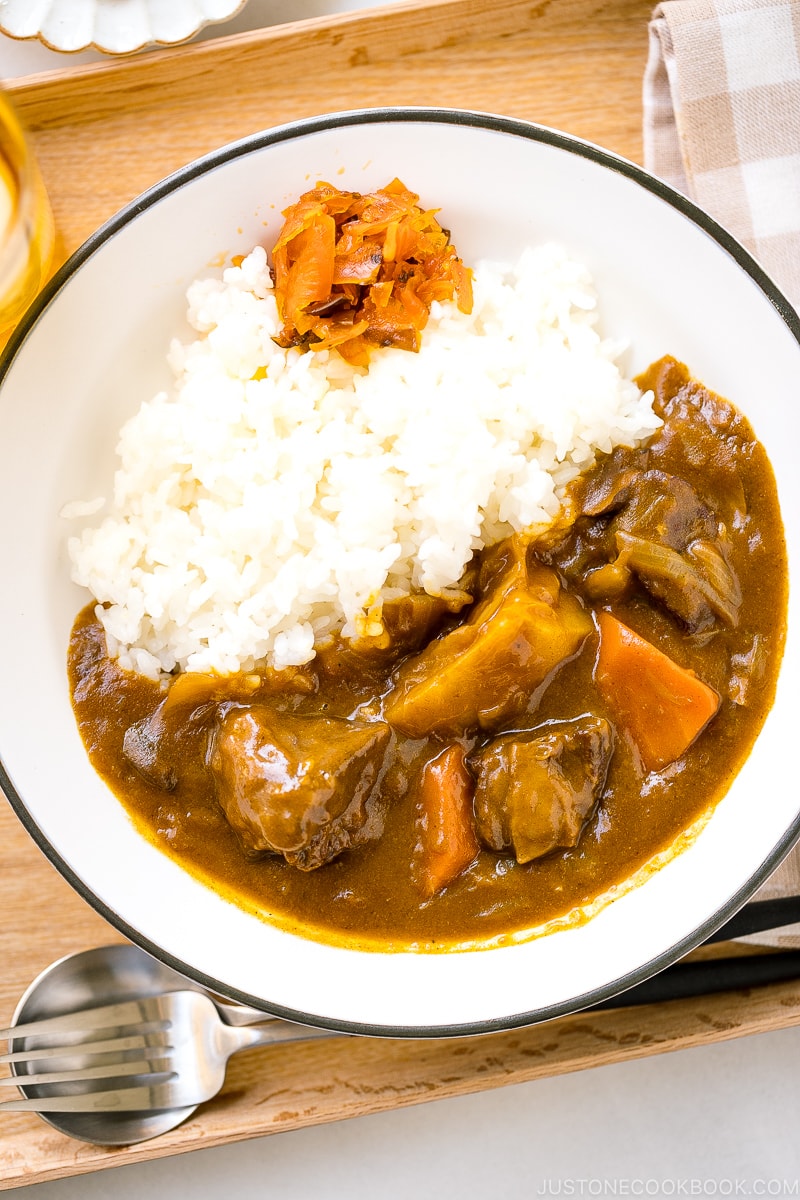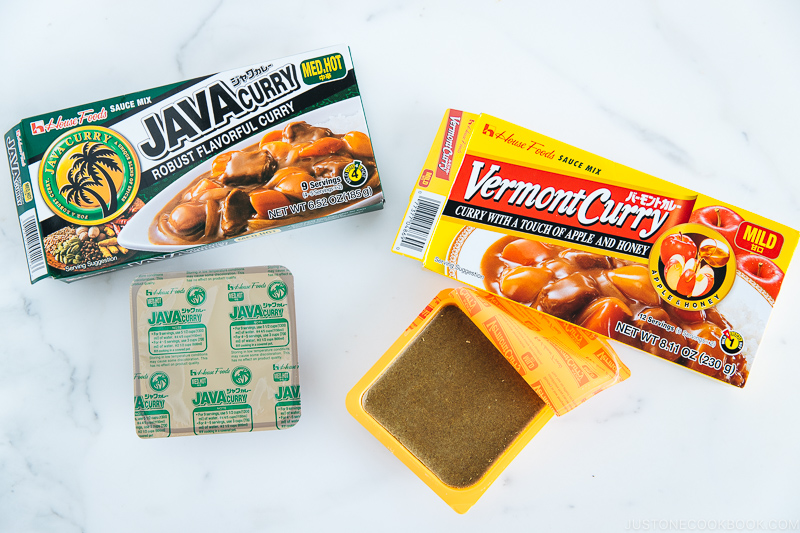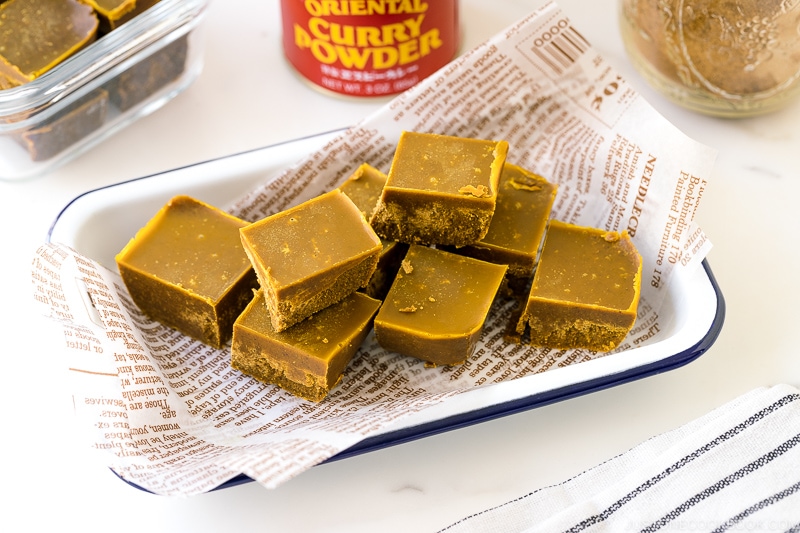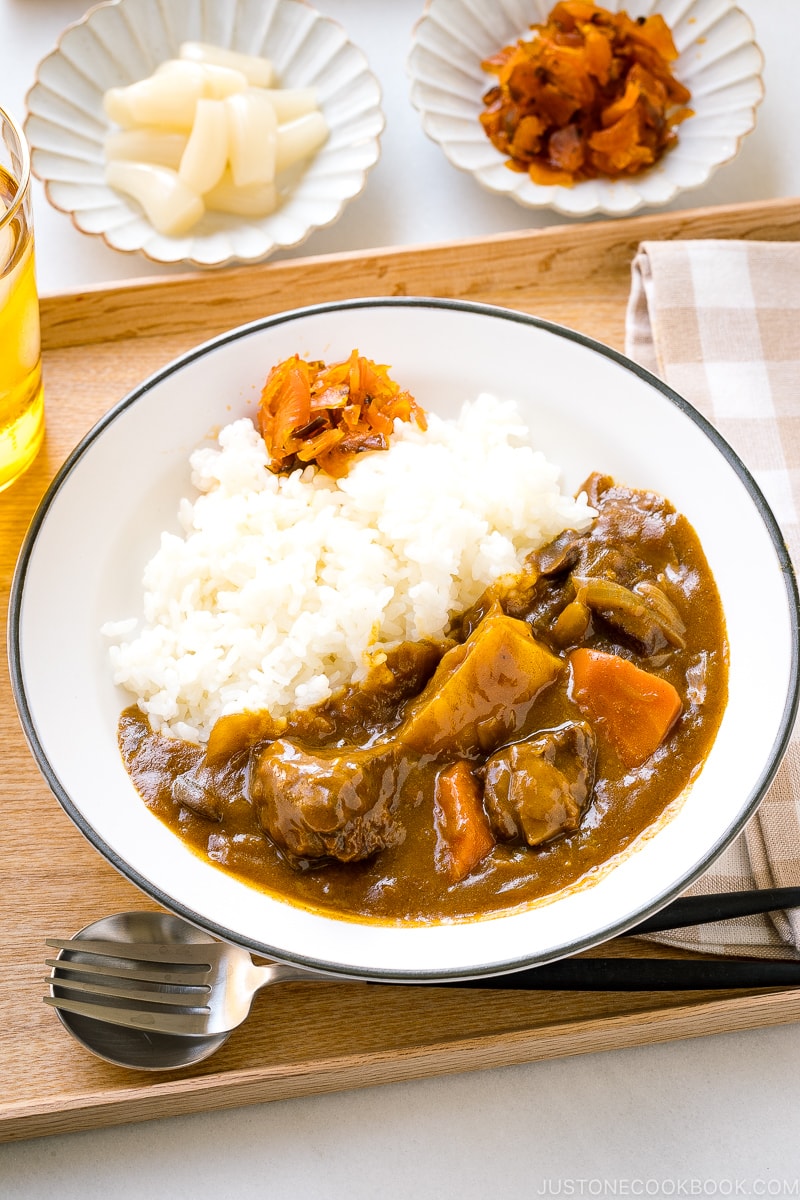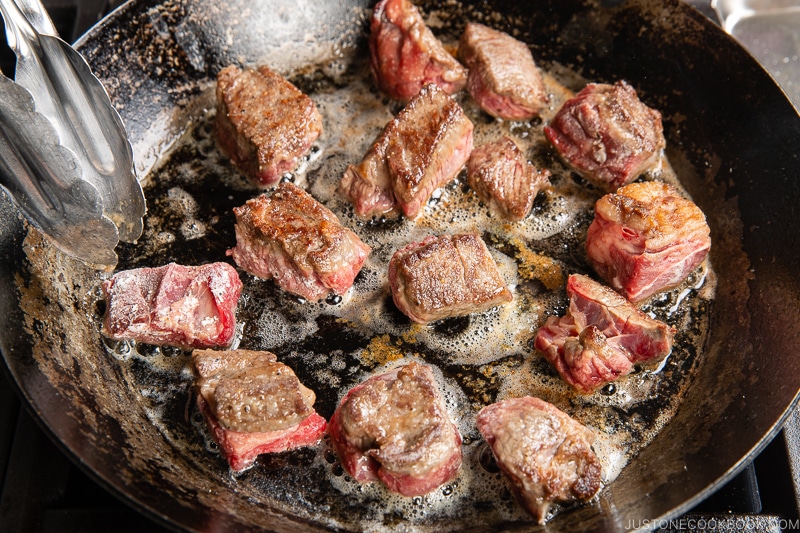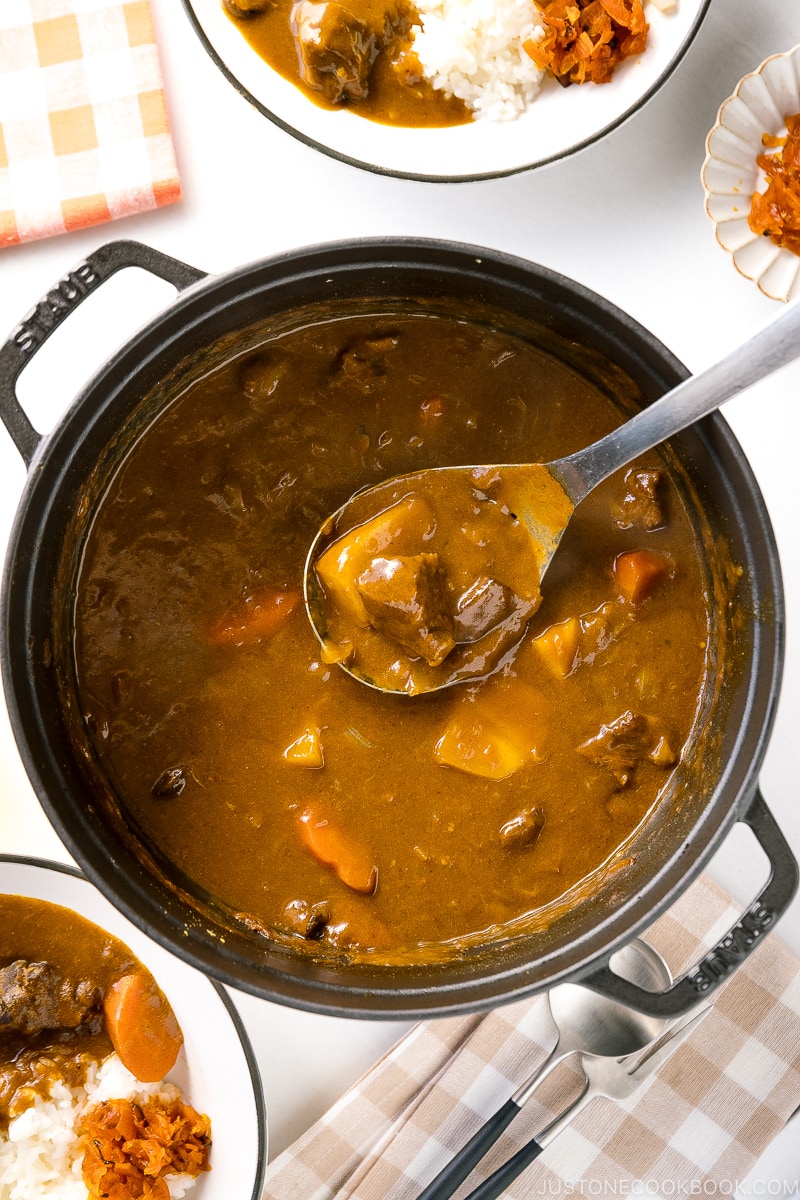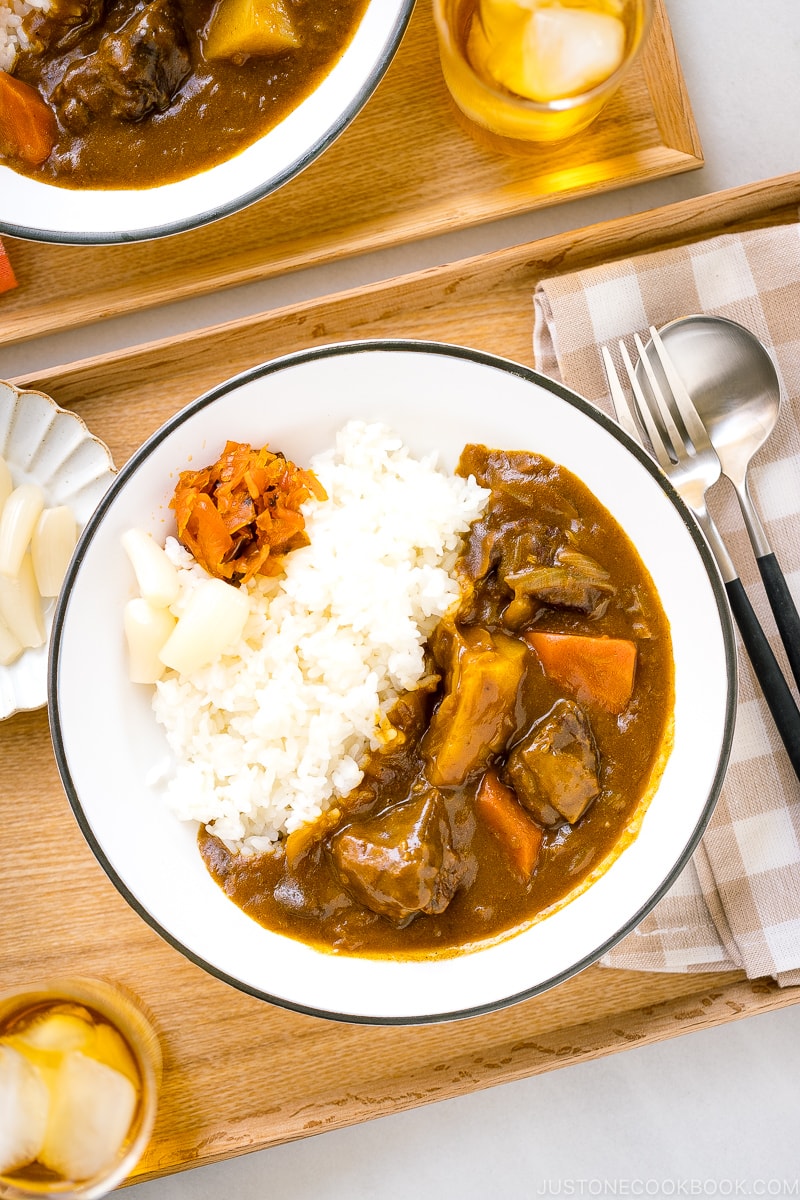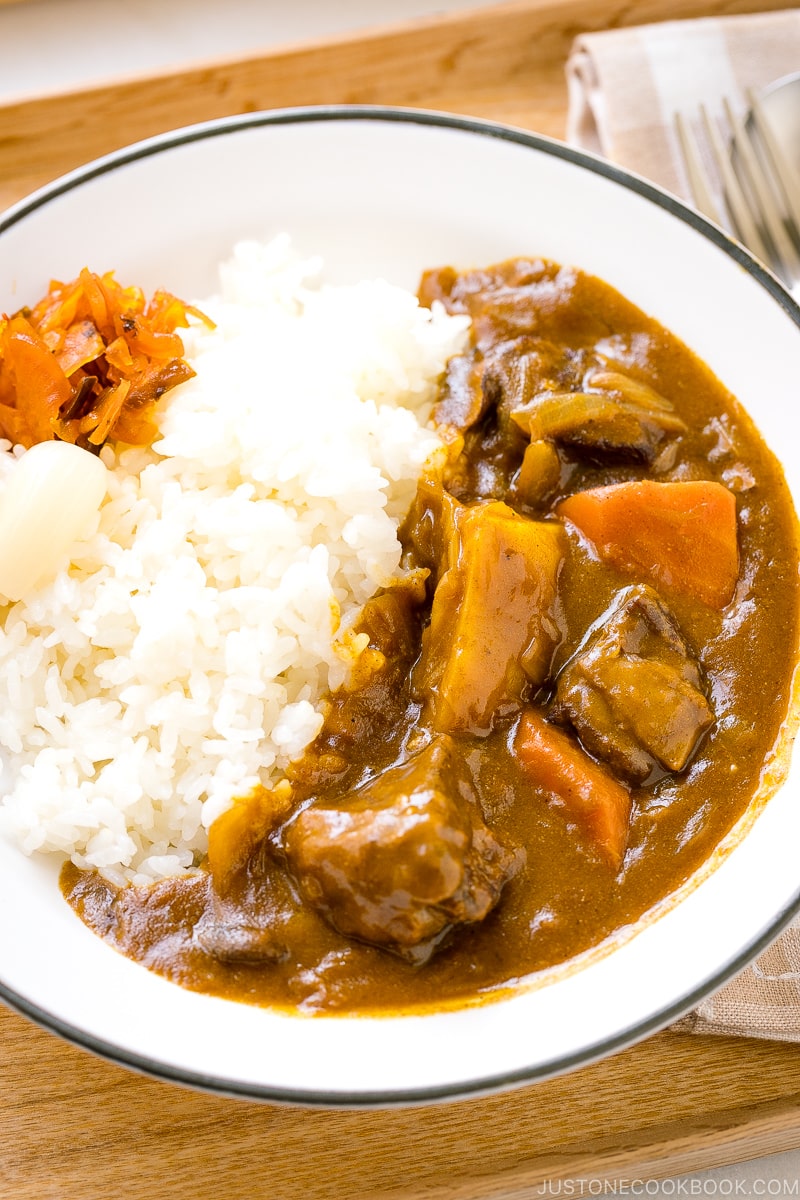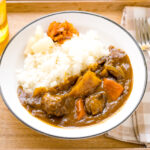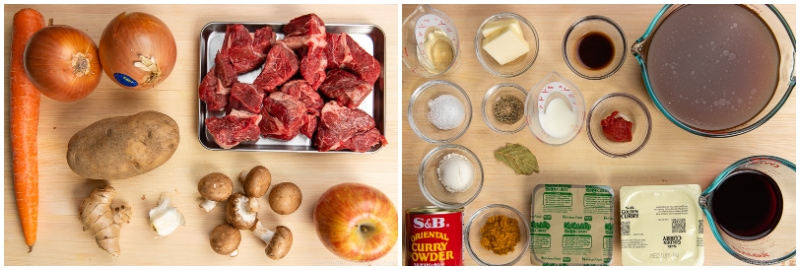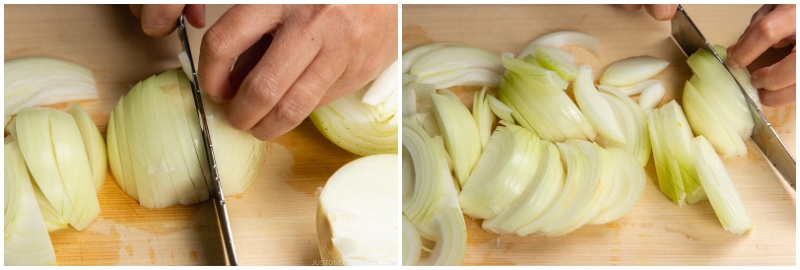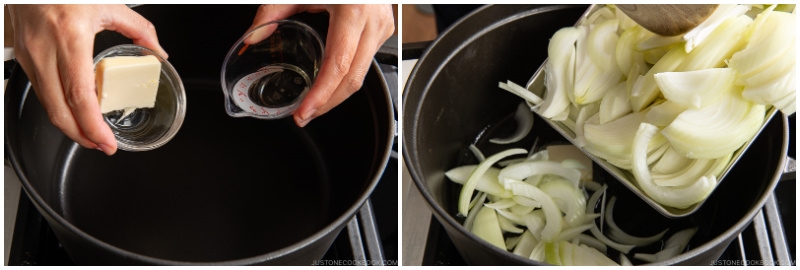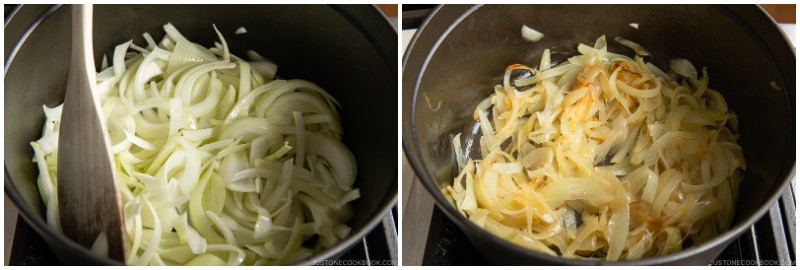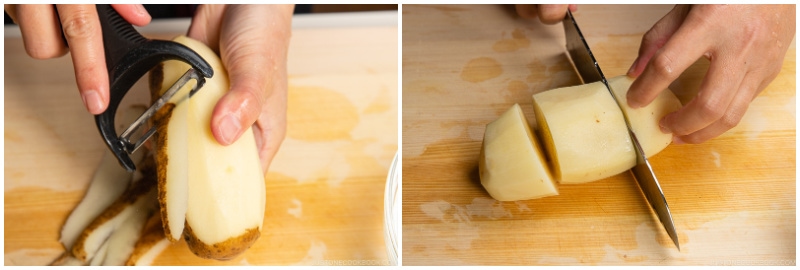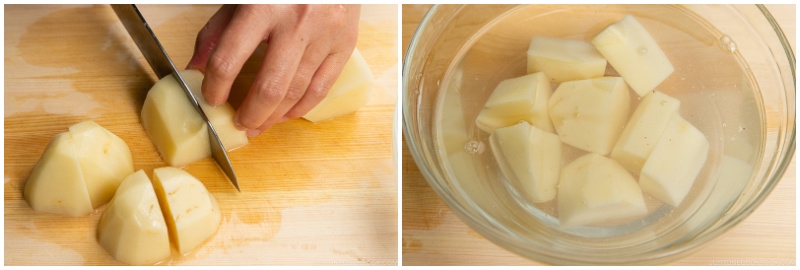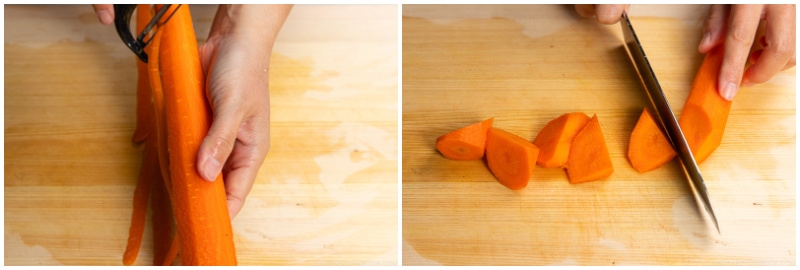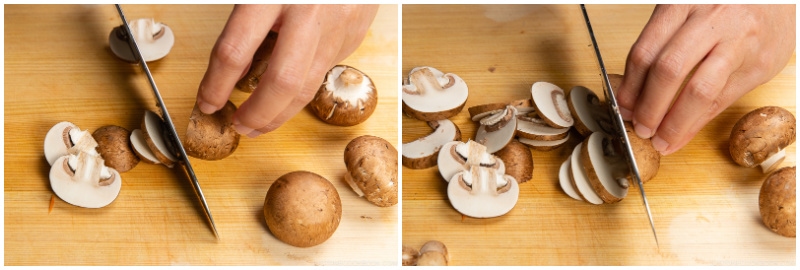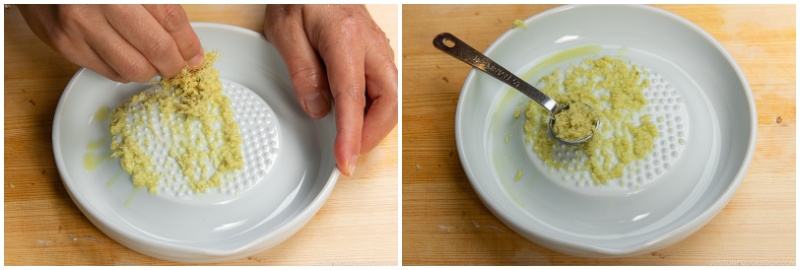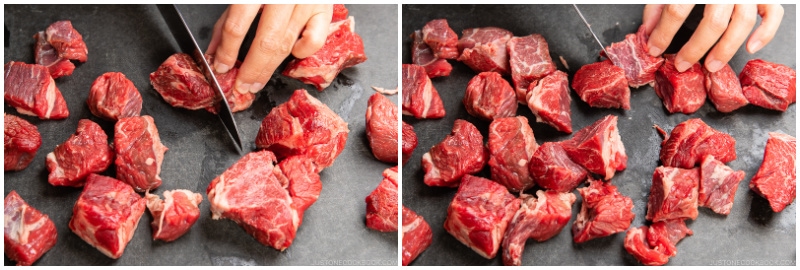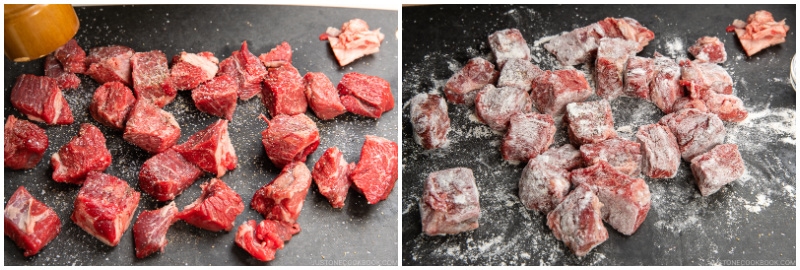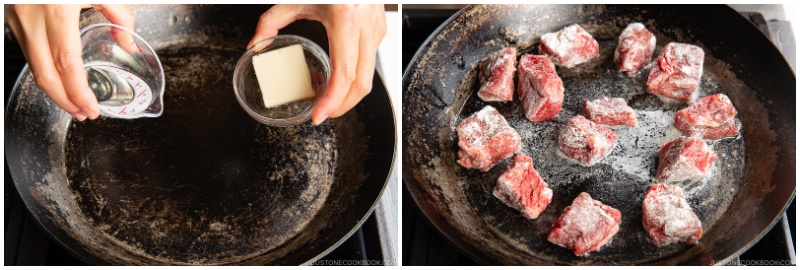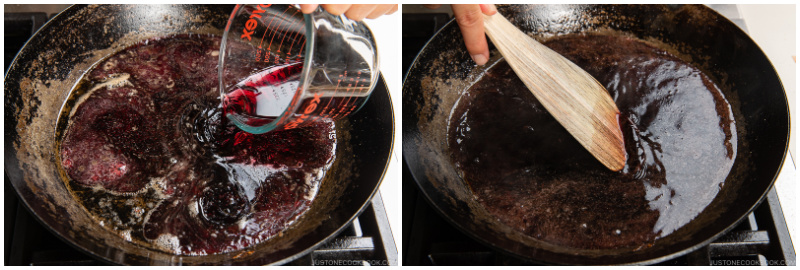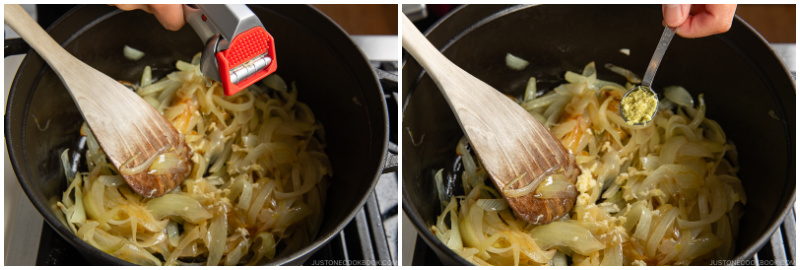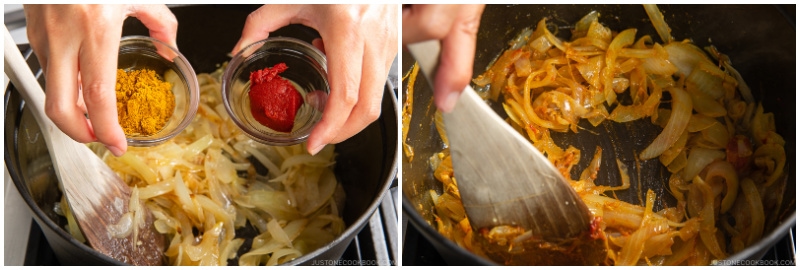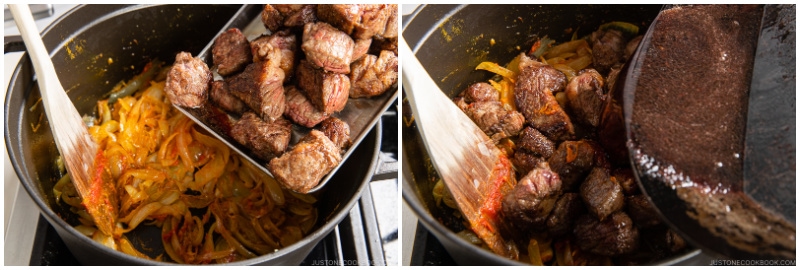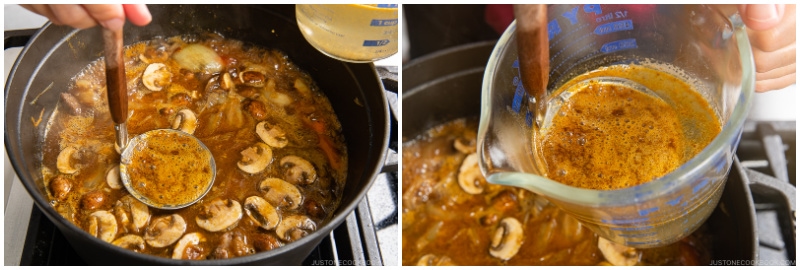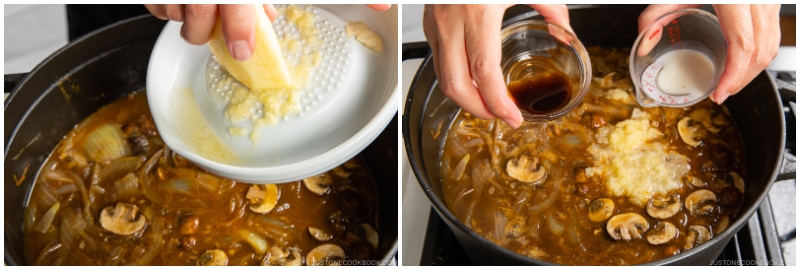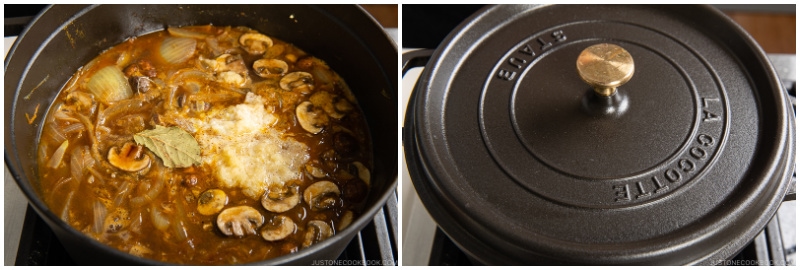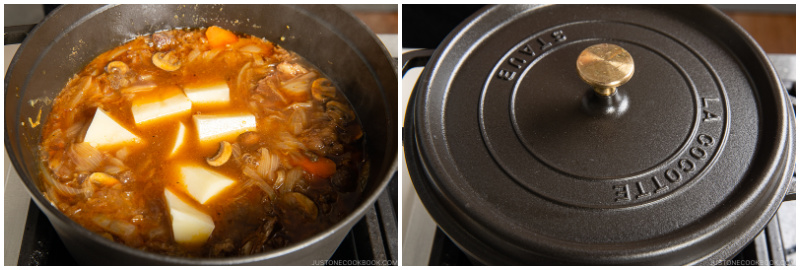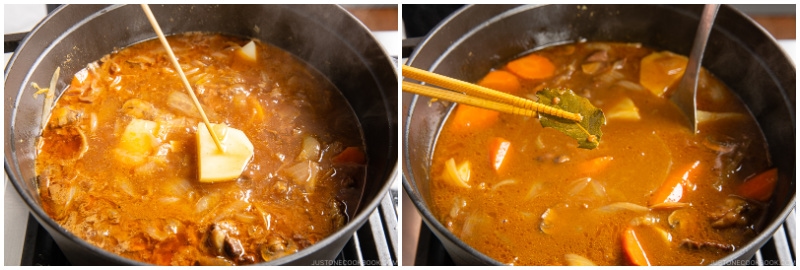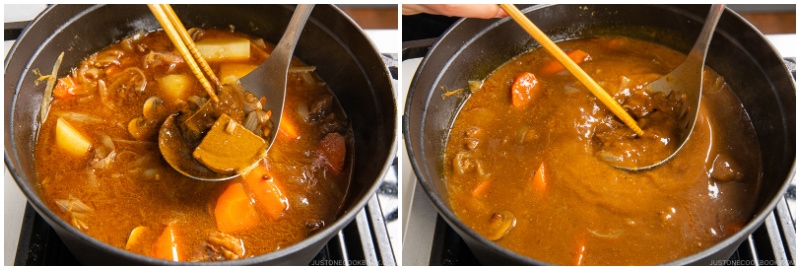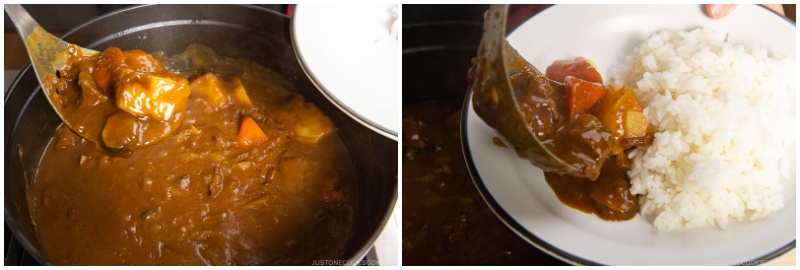Japanese Curry Rice or Karē Raisu (カレーライス) is an extremely popular dish for all ages in Japan. We adore our curry so much that it is considered one of the country’s national dishes along with ramen and gyoza! Today, I’m bringing you a most comforting Japanese Beef Curry (ビーフカレー). This takes a bit of preparation compared to the Japanese Chicken Curry but the end result is totally worth the effort and time. It’s a hearty stew that will satisfy your deepest craving.
What is Japanese Curry?
In case you’ve never tried Japanese curry, I want to quickly introduce it to you as it is quite different from Indian or Thai curry or any other rendition of curry for that matter. The dish has a long history in Japan and was in fact introduced by the British Royal Navy during the Meiji Restoration 150 years ago. However, it was not until the early twentieth century that curry became a mainstream staple in Japanese households. A classic Japanese curry commonly features tender morsels of meat, potatoes, sweet bites of onions and carrots, and a thick brown sauce that whispers in a gentle sweetness. Although most spice aficionados would describe Japanese curry as mellow, the degree of spiciness varies depending how you’d make it. One can always bring up the chili heat if preferred. These days you can find many versions of Japanese curry, with some featuring unique local ingredients and produce.
The Key Ingredient: Japanese Curry Roux
To make Japanese curry, the recipes almost always include a box of Japanese curry roux, which can be found at Japanese and Asian supermarkets or in an Asian food aisle at your local grocery stores. All the curry spices are packed in a form of solid roux resembling a block of baking chocolate. You can find them being labeled according to the spice levels of mild, medium hot, or hot. Younger children can easily enjoy the “mild” level and now that my kids are older, I mix the mild and the medium-hot for my curries. For those who have toddlers, there is even a Japanese curry roux for toddlers that you may find at Japanese grocery stores. For those who prefer tingling heat, the “hot” might not be enough for you, but you can certainly punch things up by adding in some cayenne pepper and black pepper.
Adding Flavor Boosters
To avoid “out of the box” taste, it’s very common to mix 2-3 different brands of the Japanese curry roux and add different condiments to enhance the flavor for the curry sauce. We’ll talk more about it in the cooking tip section below.
Homemade Curry Roux
Not a fan of store-bought curry roux? No problem! You can make it from scratch. You need 4-5 ingredients to make this curry roux: Butter, flour, Japanese curry powder, and garam masala (and cayenne pepper for the spicy version). When you have time to make curry roux, make a double batch, and store it in the freezer for later use!
How to Make Japanese Beef Curry
Ingredients You’ll Need
Beef (My top choice is chuck roast; read more later) Veggies: onions, potatoes, carrots Mushrooms Garlic and ginger Wine Beef stock/broth Seasonings: tomato paste, Japanese curry powder, Japanese curry roux, bay leaf, etc Optional add-ins: grated apple, milk, Worcestershire sauce
Overview: Cooking Steps
Read the recipe card below for the full ingredient list and more detailed step-by-step instructions.
5 Important Cooking Tips
1. Get Chuck Roast instead of Stew Beef
Butcher counters sell pre-cut stew beef. This cut is more economical because it’s made up of the odds and ends from other different cuts. Chuck roast, on the other hand, is from the shoulder muscles, and while initially quite tough, cubes of chuck roast can break down into tender, succulent, flavorful meat after cooking low and slow. So, for a delicious Japanese curry (and of course any beef stew recipe), I strongly recommend getting chuck roast. For really tender meat, it usually takes two hours. Do not rush the cooking process. Otherwise, the beef will be tough and chewy. Make sure there’s enough liquid and keep an eye on the dish. If you can’t get chuck roast, try round roast, rump roast, or pot roast.
2. Sear the Meat
This is an essential step if you want to make the most flavorful meat. Searing caramelizes the natural sugars in the meat and browns the proteins, forming a bronze crust on the surface that amplifies the savory flavor of the finished dish. Once the sauce is thickened, you will be rewarded with a delicious curry with tender pieces of meat in a rich, velvety sauce.
3. Caramelize the Onions
When you slow cook the onions over an extended period of time, the natural sugars in the onions caramelize, bringing out their sweetness and making them extremely flavorful. It takes time, but you can always get the other prep work done while sautéing the onions.
4. Personalize Your Curry with Flavor Boosters
The beauty of curry is its room for customization. Every cook has the freedom to enhance and personalize the flavors with different ingredients (some can be unexpected). You can see the full list in my Japanese Chicken Curry recipe, but here are some of my favorite ones:
Grated apple Honey Ketchup Butter (Add with roux) Garlic (Add while sauteeing) Ginger (Add while sauteeing) Milk Red wine Soy sauce Tonkatsu sauce or Worcestershire Sauce
Pair one or two of the above with the main ingredients of your curry. For example, I don’t use red wine unless it’s for a beef curry. Try out different combinations or change up the proportions to see what you like.
5. Add the Potatoes 15 Minutes Before Finishing
Because the beef needs to be simmered for about 2 hours, I like to add the russet potatoes toward the end of simmering. That way, we’ll retain the shape of the potatoes instead of them being dissolved into the curry sauce. You can use Yukon gold potatoes, which tend to keep their shape. But I like the floury, light, and fluffy texture of russet potatoes for the curry.
How to Serve the Curry
Japanese curry is almost always served with steamed rice. I have detailed instructions on how to cook Japanese short-grain rice in a pot over the stove, a rice cooker, an Instant Pot, or a donabe (Japanese clay pot). Serve the steamed rice in half of a shallow bowl, and then add piping-hot curry sauce to fill up the other half of the bowl. Typically, the Japanese curry is garnished with fukujinzuke (red pickled radish) and rakko (pickled shallots). Put the extra pickles in a bowl/plate on the table so you can add more as you eat.
How to Store Japanese Beef Curry
You can keep the leftovers in an airtight glass container and store them in the refrigerator for up to 3 days or in the freezer for a month. The texture of the potatoes will change in the freezer, so I recommend removing them before freezing. Defrost the frozen curry in the refrigerator for 24 hours and reheat in a pot to serve. If needed, add ¼ to ½ cup (60-120 ml) of water to dilute the curry when reheating.
I don’t have 3 hours to make curry. Are there any other recipes that are quicker?
If you want to cut down on the simmering time for beef curry, you can make my Instant Pot Pressure Cooker Japanese Curry recipe. Or try my Japanese Chicken Curry or Japanese Seafood Curry!
My broth disappeared while cooking!
When you simmer stews like this for a long period of time, it’s very important to use a heavy-bottomed pot with a tight-fitting lid. The pot I use is Staub brand and their lid seals perfectly. Le Creuset is okay, but I still see some evaporation from the gap between the lid and the pot.
Can I make a vegetarian version?
Japanese curry usually includes a protein of your choice (usually beef, chicken, pork, or seafood), onions, potatoes, and carrots. For a vegetarian option, you can add firm tofu right before you serve just to heat it through. Or make my Vegetarian Japanese Curry that is packed with a colorful medley of veggies!
Why is my meat tough and chewy after cooking?
First, I recommend getting chuck roast instead of stew beef. Beef stew meat is typically made up of the odds and ends from other different cuts. Chuck roast is a pretty tough cut, but after cooking low and slow, it becomes melt-in-your-mouth tender. Secondly, you do need to cook it for 2 hours as all the beef stew recipes do. Do not rush it. Otherwise, the beef will be tough and chewy. Make sure there’s enough liquid and keep an eye on the dish.
What to Serve with This Japanese Beef Curry Recipe
Japanese Macaroni Salad Cold Brew Hojicha (Roasted Green Tea) Chicken Katsu or Tonkatsu
More Japanese Curry Recipes You’ll Love
Curry Udon Curry Bread (Curry Pan) How to Make Japanese Curry Roux 15 Japanese Curry Recipes You’ll Love
Wish to learn more about Japanese cooking? Sign up for our free newsletter to receive cooking tips & recipe updates! And stay in touch with me on Facebook, Pinterest, YouTube, and Instagram. Editor’s Note: This post was originally published on April 15, 2011. It has been updated with new pictures and video and the recipe instruction was slightly revised on May 15, 2022.
